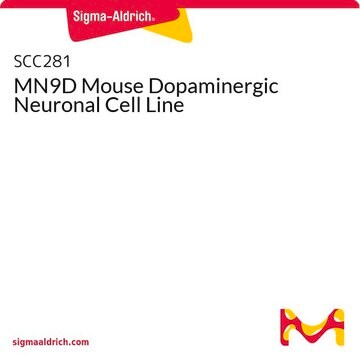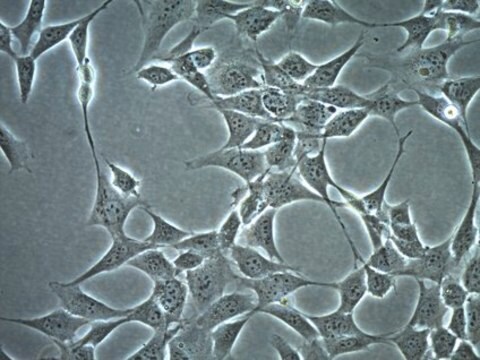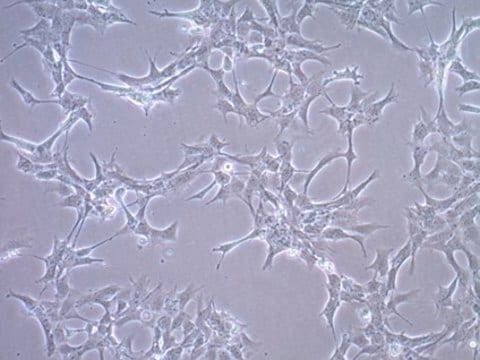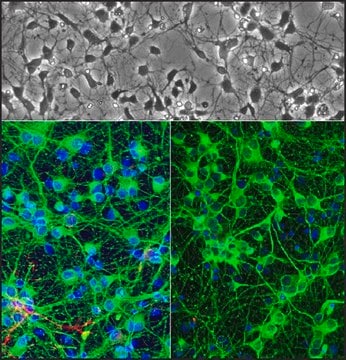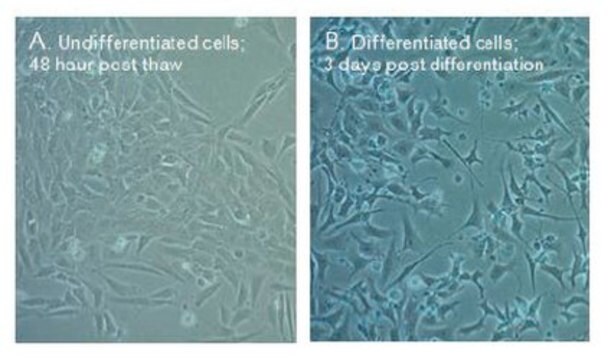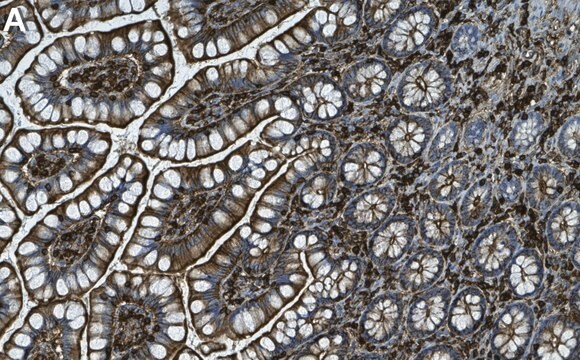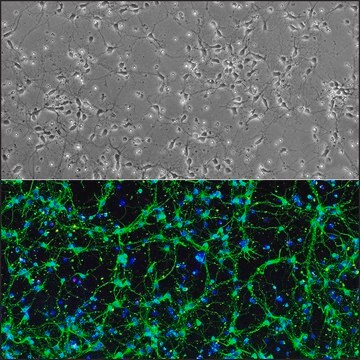SCC188
GN11 Mouse GnRH Neuronal Cell Line
The GN11 mouse neuronal cell line is an immortalized cell line established as a model of GnRH-secreting neurons.
Synonyme(s) :
GN11 cell line
Se connecterpour consulter vos tarifs contractuels et ceux de votre entreprise/organisme
About This Item
Code UNSPSC :
41106514
Nomenclature NACRES :
NA.81
Produits recommandés
Conditionnement
vial of ≥1X10⁶ cells
Technique(s)
cell culture | mammalian: suitable
Entrée
sample type neural cells (lineage)
Description générale
The GN11 cell line was derived from a transgenic mouse expressing Simian virus-40 (SV40) large T antigen driven by the human GnRH promoter (3). An olfactory bulb tumor from one male GnRH promoter-SV40T fusion-expressing transgenic mouse were dispersed and the GN11 cell line was established from serial dilution and cloning from the primary cells.
Gonadotropin-releasing hormone (GnRH) is important for control of reproduction in all mammals, acting to stimulate the synthesis and secretion of follicle-stimulating hormone and luteinizing hormone from the pituitary gland (1).GnRH is secreted by specialized neurons that migrate from the olfactory bulb to the brain during embryonic development. GnRH neurons are highly sensitive to glucose and insulin, suggestive of their physiological role in sensing the metabolic status in preparation for reproduction (2). Defects in GnRH neuronal function result in subfertility and developmental abnormalities. The scattered distribution and scarcity of GnRH neurons in the brain complicate the in vivo study of these cells and necessitate the utilization of robust in vitro cell models.
The GN11 mouse neuronal cell line is an immortalized cell line established as a model of GnRH-secreting neurons (3). In addition to GnRH expression, GN11 cells display neuron-specific markers including microtubule-associated protein 2 (MAP2) and Tau (4). GN11 cells express insulin receptor (5) and are responsive to steroid hormones (6). The GN11 GnRH-secreting neuronal cell line has proven a valuable system for exploring the cellular mechanisms of neuroendocrine reproductive physiology.
Gonadotropin-releasing hormone (GnRH) is important for control of reproduction in all mammals, acting to stimulate the synthesis and secretion of follicle-stimulating hormone and luteinizing hormone from the pituitary gland (1).GnRH is secreted by specialized neurons that migrate from the olfactory bulb to the brain during embryonic development. GnRH neurons are highly sensitive to glucose and insulin, suggestive of their physiological role in sensing the metabolic status in preparation for reproduction (2). Defects in GnRH neuronal function result in subfertility and developmental abnormalities. The scattered distribution and scarcity of GnRH neurons in the brain complicate the in vivo study of these cells and necessitate the utilization of robust in vitro cell models.
The GN11 mouse neuronal cell line is an immortalized cell line established as a model of GnRH-secreting neurons (3). In addition to GnRH expression, GN11 cells display neuron-specific markers including microtubule-associated protein 2 (MAP2) and Tau (4). GN11 cells express insulin receptor (5) and are responsive to steroid hormones (6). The GN11 GnRH-secreting neuronal cell line has proven a valuable system for exploring the cellular mechanisms of neuroendocrine reproductive physiology.
Application
This product is intended for sale and sold solely to academic institutions for internal academic research use per the terms of the “Academic Use Agreement” as detailed in the product documentation. For information regarding any other use, please contact licensing@emdmillipore.com.
Conditionnement
≥1X10⁶ cells/vial
Qualité
- Each vial contains ≥ 1X10⁶ viable cells.
- Cells are tested negative for infectious diseases by a Mouse Essential CLEAR panel by Charles River Animal Diagnostic Services.
- Cells are verified to be of mouse origin and negative for inter-species contamination from rat, chinese hamster, Golden Syrian hamster, human and non-human primate (NHP) as assessed by a Contamination CLEAR panel by Charles River Animal Diagnostic Services.
- Cells are negative for mycoplasma contamination.
Stockage et stabilité
Store in liquid nitrogen. The cells can be cultured for at least 10 passages after initial thawing without significantly affecting the cell marker expression and functionality.
Clause de non-responsabilité
This product contains genetically modified organisms (GMO). Within the EU GMOs are regulated by Directives 2001/18/EC and 2009/41/EC of the European Parliament and of the Council and their national implementation in the member States respectively. This legislation obliges Merck to request certain information about you and the establishment where the GMOs are being handled. Clickhere for Enduser Declaration (EUD) Form.
Unless otherwise stated in our catalog or other company documentation accompanying the product(s), our products are intended for research use only and are not to be used for any other purpose, which includes but is not limited to, unauthorized commercial uses, in vitro diagnostic uses, ex vivo or in vivo therapeutic uses or any type of consumption or application to humans or animals.
Unless otherwise stated in our catalog or other company documentation accompanying the product(s), our products are intended for research use only and are not to be used for any other purpose, which includes but is not limited to, unauthorized commercial uses, in vitro diagnostic uses, ex vivo or in vivo therapeutic uses or any type of consumption or application to humans or animals.
Code de la classe de stockage
10 - Combustible liquids
Classe de danger pour l'eau (WGK)
WGK 2
Point d'éclair (°F)
Not applicable
Point d'éclair (°C)
Not applicable
Certificats d'analyse (COA)
Recherchez un Certificats d'analyse (COA) en saisissant le numéro de lot du produit. Les numéros de lot figurent sur l'étiquette du produit après les mots "Lot" ou "Batch".
Déjà en possession de ce produit ?
Retrouvez la documentation relative aux produits que vous avez récemment achetés dans la Bibliothèque de documents.
Notre équipe de scientifiques dispose d'une expérience dans tous les secteurs de la recherche, notamment en sciences de la vie, science des matériaux, synthèse chimique, chromatographie, analyse et dans de nombreux autres domaines..
Contacter notre Service technique